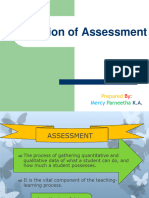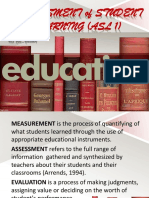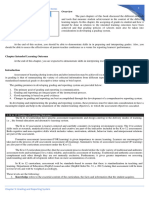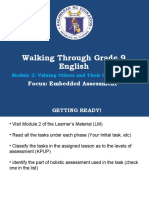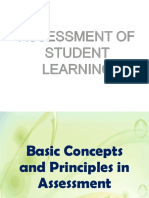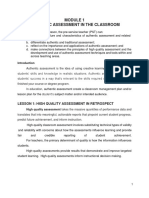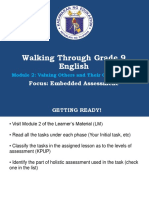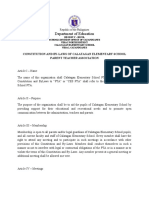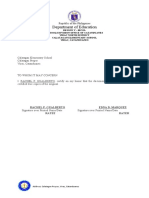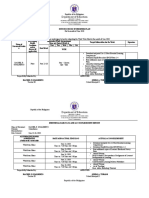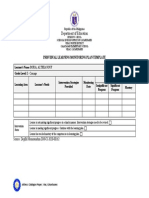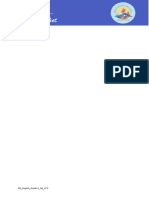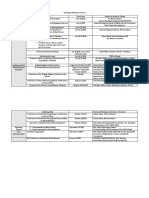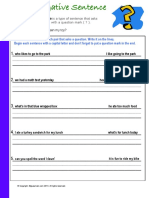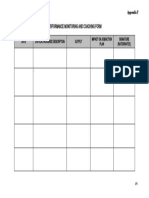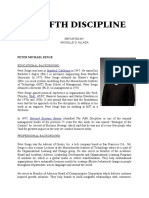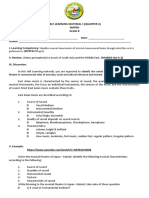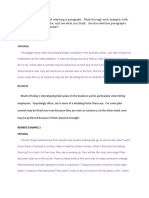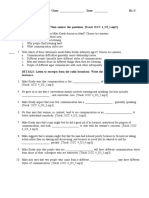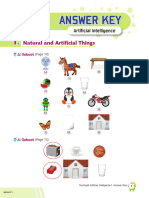ASSESSMENT
IN THE K TO 12 BASIC EDUCATION
CURRICULUM
Per DepEd Order No. 73, s. 2012
Guidelines on the Assessment and
Rating System of Learning Outcomes
Under the K to 12 Basic Education
Curriculum
�Activity
Who are responsible for learning? Why?
Why is it necessary to assess students
before, during and after the lesson?
How do we assess learning?
What do we assess as evidence of
learning?
What makes a holistic assessment?
�Philosophy
Assessment shall be used primarily as a quality
assurance tool to track student progress in the
attainment of standards, promote self-reflection
and personal accountability for ones learning,
and provide a basis for the profiling of student
performance.
�Nature and Purpose of Assessment
Assessment shall be holistic, with emphasis on the
formative or developmental purpose of quality assuring
student learning.
Assessment is also standards-based as it seeks to ensure
that teachers will teach to the standards and students will
aim to meet or even exceed the standards
The students attainment of standards in terms of content
and performance is a critical evidence of learning
�Principles of Assessment
Assessment as Learning
Assessment for Learning
Assessment of Learning
�Assessment as learning
develops in the learner personal responsibility for
learning.
begins as the learner becomes aware of the goals
of instruction and the criteria for performance.
He/ she generates his/her personal learning goals
based on standards set, monitors his/her
progress by regularly undertaking informal and
formal self-assessment and by actively reflecting
on his/her progress (meta-cognition) in relation
to his/her personal goals.
�Assessment for learning
This refers to formative assessment.
The teacher and learner use assessment primarily
to improve learning and teaching.
It is about assessing progress, analyzing and
feeding back the outcomes of assessment
positively and constructively.
It is given at the beginning of teaching (diagnostic)
or in the process of teaching (formative) to guide
instruction and decision making
�Assessment of learning
referred to as summative assessment.
designed to measure the learners achievement
at the end of a unit or module or quarter to
determine what he/she has learned in
comparison with content and performance
standards.
assessment results are the bases of grades or
marks which are communicated to learners and
parents.
�Under the K to 12 curriculum, students will be assessed at
four levels and shall be weighted as follows: (DepEd Order
Nos. 31 and 73, s. 2012)
Level of Assessment
Knowledge
Process or Skills
Understanding(s)
Products/Performances
Percentage Weight
15%
25%
30%
30%
100%
�Assessment
The process of collecting and
documenting information on
individual pupil learning
�Assessment can be through
traditional assessments
alternative assessments
�Instruments and Techniques of Assessm
a. Traditional assessments
- are tests given to the students to
measure how much the students
have learned
- contain different types of questions
such as multiple-choice, true-false,
fill-ins, essays, sentence
completions, matching response,
etc.
�Instruments and Techniques of Assessm
b. Alternative Assessment
Observation
Student journals
Performance assessment
Project and investigation
�Instruments and Techniques of Assessme
b. Alternative Assessment
Open-ended questions
Student portfolio
Interview
Role Play
Checklist
�Knowledge (15%)
Selected response Item
Multiple Choice
True or False
Matching Type
Others
�Process or Skills (25%)
Outlining, organizing, analyzing, interpreting, translating,
converting, or expressing the information into another
format;
Drawing analogies
Constructing graphs
Making models
Using flowcharts and mind maps or graphic organizers
Transforming a textual presentation into a diagram
Drawing or painting pictures
Doing role play
Written test
�Understanding (30%)
Oral Discourse/Recitation
Explain/justify something based on facts
Interpret
Give perspective
Show empathy
Self-knowledge
Interview
Make connections
Apply
Portfolio collection of evidence
Open-ended tests
�Products/Performance (30%)
Participation
Observation
Projects
Homework
Experiments
Portfolio
Other outputs
�Bigyan ng puntos ang mga mag-aaral ayon sa
sumusunod na bahagdan ng bawat antas ng
KPUP:
Antas ng Pagtatasa
Bahagdan
Kaalaman
15%
Kasanayan/ proseso
25%
Pag-unawa
30%
Produkto/ performans
30%
100%
�Kaalaman (Knowledge)
1. Kaalaman ito ang mahalagang
nilalaman ng kurikulum, ang mga
datos at impormasyon na natutuhan
ng mga mag-aaral
o Ano ang kailangan malaman ng mga magaaral?
o Ano-ano ang mga pagkakataon na maipakita
ng mga mag-aaral ang kanilang natutuhan?
DEPARTMENT OF EDUCATION
�Kaalaman (Knowledge)
Halimbawa:
Iugnay ang mga lalawigan sa hanay B sa
kanilang rehiyon sa hanay A. Isulat ang pangalan ng
lalawigan sa loob ng angkop na hugis.
Hanay A
IV A
Hanay B
III
IV B
A. CAVITE
B. PALAWAN
C. ILOCOS NORTE
D. BULACAN
II
DEPARTMENT OF EDUCATION
�2. Kasanayan ito ay tungkol sa mga
kognitibong proseso na ginagamit ng
mag-aaral
sa
pagsagot
upang
maunawaan niya ang bagong aralin
gamit ang mga kaalaman niya tungkol
dito.
o
Ano ang gusto nating gawin ng mga magaaral sa mga impormasyong kanilang
natutuhan?
Ano ang mga dapat na maipakita ng mga
mag-aaral bilang ebidensya ng kanilang
DEPARTMENT OF EDUCATION
�Prosesong Kasanayan - Process Skill
1. Pumili ng isang lugar na gusto ninyong puntahan.
2. Humanap ka ng kaklase na pareho sa iyo ang napili lugar na nais
puntahan.
3. Sabihin sa iyong kaklase ang iyong dahilan sa pagpili ng naturang lugar.
Pagkatapos ay siya naman ang magsasabi kung bakit niya napili ang
kaparehong lugar.
***Sa harap ng klase, magtatanong ang guro kung naniwala sila sa
kanilang kaklase at ipapaliwanag ang Pagtanggap sa opinyon ng iba.
BOHOL
LEYTE
BULACAN
GEN.
SANTOS
QUEZON
PALAWAN
ILOCOS
NORTE
MANILA
DEPARTMENT OF EDUCATION
MAGUINDANAO
�3. Pag-unawa ito ang pangunahin
kaisipan at konsepto ng asignatura na
mahalagang maunawaan ng mga magaaral
o Ano ang pagkakaunawa ng mga mag-aaral
tungkol sa mga pangunahing kaisipan o
konsepto sa isang markahan?
o Ano ang kailangan nilang ipakita bilang
ebidensiya ng kanilang pagkaunawa sa
pangunahing kaisipan?
DEPARTMENT OF EDUCATION
�3. Pag-unawa
a. Paliwanag nakapagbibigay ng halimbawa at
nasasabi ang ugnayan ng mga impormasyon
upang makabuo ng kaisipan
b. Interpretasyon nakapagbibigay ng sariling
paglalarawan sa pamamagitan ng pag-ugnay
ng konsepto sa sariling karanasan
c. Paglalapat nailalapat ang natutuhan sa ibang
konteksto lalo na sa sariling buhay
d. Pagbibigay ng sariling perspektibo batay sa
mga ebidensiya
DEPARTMENT OF EDUCATION
�Pag-unawa (Understanding)
Ano ang iyong mararamdaman sa
malawakang pagpuputol ng mga puno
sa kagubatan?
Pag-unawa (Understanding)
Ako ay masaya/ malungkot dahil
__________________________________________________________________
__________________________________________________________________
__________________________________________________________________
__________________________________________________________________
__________________________________________________________________
__________________________________________________________________
__________________________________________________________________
__________________________________________________________________
_______________________________________________________________.
DEPARTMENT OF EDUCATION
�4. Produkto/ performans- ito ay ang
papakita ng kakayahan sa
paglalapat ng natutuhan sa
makatutohanang situwasyon sa
ibat ibang pamamaraan.
o
Ano ang dapat na maipakitang
produkto ng mga mag-aaral bilang
ebidensya ng kanilang pagkatuto?
Ano ang pagkakataon na maipakita
nila ang kanilang kakayanan?
DEPARTMENT OF EDUCATION
�Resulta/Perpormans
Halimbawa:
Sa islogan ng Kagawaran ng
Turismo na ITS MORE FUN IN THE
PHILIPPINES, sa paanong paraan
mo maipapakita ang kagandahan
ng iyong lalawigan sa pamamagitan
ng paggawa ng travelogue.
DEPARTMENT OF EDUCATION
�LEVELS OF
ASSESSMENT
BLOOMS
TAXONOMY
Performance
Creating
Understanding
Judging
Analyzing
Process/Skills
Applying
Understanding
(comprehension)
Knowledge
Remembering
�Bilang ng Aytem
Layunin
Bilang ng Araw
ng Pagtuturo
Bilang
Kinalalagyan
ng
Knowledge
Process
Understanding
Performance
ng Aytem
Aytem
15%
25%
30%
30%
6
10
12
12
10
11
12
13
54
40
10
12
12
1-2
no. of test items = no. of
days/total number of
days (quarter) * no. of
items
40
�Knowledge (15%)
20
15
20
13
10
PT Total
Process (25%)
41
15
40
37
13.54
19
7.70
Understanding (30%)
PT Total
20
10
70
37
15
20
PT Total
FINAL
RATING
25 40
12
77
30
100
53
22.08 20 30
55
21.4
78
40
22.64 15
51
27.8
72
PT
Total
25
30 30
12
72
30
60
21.43
25 20
33
13.75
15
20
Products/ Performances
(30%)
sum of raw scores/ sum of expected scores x .___%x 100 = +-
30
�Unang Antas: Pag-alala
( Knowledge)
Dating kaalaman/pagbabalik-alaala
sa katotohanan, termino,
pangunahing konsepto at sagot
Ano
Kailan
Saan
Sino
�Ikalawang Antas: Pag-unawa
Understanding)
Pag-unawa sa mga katotohanan at
ideya/pagsasaayos, paghahambing,
pagsasalin, pagbibigay-kahulugan,
paglalarawan, paglalahad ng pangunahing
ideya
paghambingin interpret
pagkontrast
ipakita
klasipikahin
ipaliwanag
palawakin
buuin
isalin
ipakita
rephrase
maghinuha
balangkasin
�Ikatlong Antas: Aplikasyon
( Process/Skills)
Paglutas ng problema, paglalapat ng
natutuhang kaalaman, katotohanan,
pamamaraan, at tuntunin sa ibang paraan
ikapit
bumuo
pumili
piliin
magdebelop
nag-interview
gamitin ang
lutasin
organisahin
mag-eksperimento
magplano
imodelo
�Analisis/Pagsusuri (Process/Skills)
Pag-eksamin at paghahati-hati sa bahagi ng
impormasyon, pagkilala ng motibo o sanhi;
paggawa ng hinuha at paghanap ng
ebidensiya sa suportang paglalahat
suriin
kontrast
eksaminin
lumahok sa
kategoryahin
diskubrehin
simplikahin
dissect
paghambingin
paghatiin
mag-survey
�Ebalwasyon/Paglalapat ( Process/ Skills)
Pagharap at pagtatanggol ng opinyon;
paggawa ng pasya o hatol tungkol sa
impormasyon, validiti ng ideya o kalidad ng
gawa batay sa set ng criteria
igawad
pagpasyahan
piliin
pagtalunan
buuin
i-evaluate
paunahin
pangatwiranan
bigyang interpretasyon
tutulan
tasahin
sukatin
paghambingin
markahan
magrekomenda
ipaliwanag
bigyang prayoridad
�Ikaapat na Antas: Sintesis/Pagbubuo
( Performance)
Pagsasama-sama ng impormasyon sa ibat
ibang paraan tungo sa bagong pardon o
alternatibong solusyon, paglikha ng bago o
orihinal
bumuo
mungkahi
piliin
magdevelop
pagsamahin mag-imbento
mag-disenyo magplano
gumawa ng teorya
pagbutihin
bumalangkas
lutasin
talakayin
baguhin
tanggalin
baguhin
subukin
�Use of feedback
Results of the assessment across levels should be fed
back immediately to students, cosistent with the principle
of assessment as learning.
Students need to learn from the results of the
assessment so they know what to improve further.
�Classroom Assessment Strategies
Selected
Response
Multiple Choice
True or False
Matching Type
Constructed
Response
Fill-in the blanks
Essay
Short Answer
(Sentences,
Paragraphs)
Flowchart
Diagram
Graph
Concept Map
Drawing/Illustration
Table
Matrix
Performance
Assessment
Presentation (Group,
Individual)
Movement
Science
lab/experiment
Math investigation
Dramatization or
Role Play
Simulation/Enactment
Project
Debate
Making models
Recital
Athletic skill
Exhibition
Telling/Retelling
stories
Informal
Assessment
Oral Discourse
Oral Questioning
Interview
Observation
Checklist
Rating scale
Journal writing
Process
Description
Peer Review
Portfolio
�Sample Test Items
�Assessment of Knowledge
Encircle the letter that tells the number of
objects in a set.
1.
A. 8
B.
C. 6
�Assessment of Knowledge
Which set has five objects?
A.
B.
C.
�Assessment of Process/Skills
Which set has one more object than this
set?
A.
C.
B.
�English (Knowledge)
to your teacher and encircle the letter of the
1 Listen
correct answer.
This is Paulo Moran.
He is six years old.He is in
Grade 1.
His mother is Aling Cora.
1. Who is this boy?
A. Paulo Marin
B. Paulo Moran
C. Paulo Mora
2. How old is he?
A. Four
B. Five
C. Six
3. In what grade is he?
A. Grade 3
B. Grade 2
C. Grade 1
4. Who is Aling Cora
?
A. Aunt
B. Mother
C. Brother
�English (Knowledge)
to your teacher and encirlce the letter of the
1 Listen
correct answer
A. Encircle the correct object?
1 Which is a ball?
A.
B.
C.
B. Which object do we use for writting?
A.
B.
C.
�English (Understanding)
Compare the leaves in the trees or plants and the leaves that
fell on the ground. What is the difference?
Tell the class about it.
Process/Skills
1) Draw a picture of your family.
2) Introduce and tell something about each
member of your family to the class.
�Filipino
Knowledge
1. Bilugan ang pangalan ng bagay na nasa larawan
sa kaliwa
payong
suklay
2.Bilugan ang tamang larawan.
Tao
A.
C.
B.
D.
3. Suriin ang pangungusap isulat ang tamang sagot
Sa patlang.
Ano ang pangalan mo?
Ang pangalan ko ay ______________
sepilyo
�Filipino (Process/Skills)
Pag-aralan ang mga larawan. Ilagay ang titik ng mga larawan sa
tamang pangkat na nasa tsart.
A.
B.
C
.
D.
E.
F.
G.
PANLALAKI
PAMBABAE
Di-Tiyak
UNDERSTANDING
Pakikinig sa tula na binabasa ng guro. Magbigay ng mga
tanong tungkol sa tula
�Assessment of Understanding (Araling
Panlipunan)
Pag-aralan ang larawan
at sagutin ang mga tanong tungkol
dito.
1. Anong klaseng bata ang nasa larawan? Bakit?
2. Anu-ano ang mga pangangailangan ng bata na
nasa larawan?
�Identify and use the pattern of naming ordinal
numbers from 1st to 20th
KNOWLEDGE
This is the order/rank in the list of top 3 pupils in
the class of Mrs. Espinoza
Rank
Name
Orly
Kenneth
Yra
What is the rank/order of Kenneth?
What is the rank/order of Yra?
What is the rank/order of Orly?
�Identify and use the pattern of naming
ordinal numbers from 1st to 20th
KNOWLEDGE
Fill in the blanks.
a.
b.
c.
d.
e.
Sunday is the ____day of the week.
Friday is the ___ day school of the week.
December is the ____ month of the year.
January is the ___ month of the year.
Monday is the ____ day of the week.
�Identify and use the pattern of naming
ordinal numbers from 1st to 20th
KNOWLEDGE
How do we write ordinal numbers in words? in
figures?
Numeral
one
nine
twelve
seventeen
twenty
fifteen
Ordinal in words
Ordinal in
figures
�Identify and use the pattern of naming ordinal
numbers from 1st to 20th
PROCESS/SKILLS
The largest number of rings ever counted in a tree is
280. What is that tree? This tree can be revealed by
answering the clues below.
a. It starts with the nineteenth letter of the alphabet.
b. The second letter is between D and F.
c. The third letter is the 17th letter of the alphabet.
d. The fourth letter is between T and V
e. The fifth letter is the fifteenth letter of the alphabet.
f. Sixth letter is I
g. The seventh letter is the first letter of the alphabet
�Identify and use the pattern of naming ordinal
numbers from 1st to 20th
UNDERSTANDING
Given these figures arranged in a row,
describe the position of each figure using a
reference point.
�Identify and use the pattern of naming
ordinal numbers from 1st to 20th
Products/Performance
Draw your FAMILY TREE starting from your
grandparents.
Include all the names of grandparents
children and so on.
Write a short paragraph using ordinal
numbers.

















